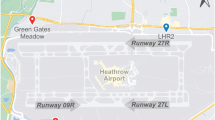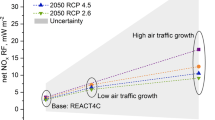Abstract
Pollution of the stratosphere by aircraft is increasing because of the growth in air traffic and a general increase in aircraft cruise altitudes. This paper analyzes aircraft route frequencies on those routes where aircraft routinely fly above the tropopause, and estimates the fuel burned per year above the tropopause since 1960. Predictions to 1990 incorporate the increasing numbers of high-flying, wide-bodied subsonic aircraft, and the introduction of the civil supersonic transport. The factors which are important in quantifying stratospheric pollution are discussed. It is suggested that by 1990, within the rather large uncertainties inherent in these predictions, about 40% of the total fuel burned in the stratosphere could be by civil supersonic aircraft. From a breakdown of the various engine types in service, it is possible to estimate the nitrogen oxides emitted by aircraft. Nitrogen oxides emitted by civil supersonic aircraft in the stratosphere are estimated to be about 50% of the total by 1990, but because of the higher cruise altitudes of the supersonic fleet, the contribution from this source to the overall effects of these pollutants will be greater than that from subsonic aircraft.
Similar content being viewed by others
References
Barrington, A. E. (ed.): I972, Climatic Impact Assessment Program',Proc. of the Survey Conference, February 15–16, 1972, U.S. Dept. of Transportation, DOT-TSC-OST-72-13.
Beckwith, W. B.: 1972, Paper presented at theInternational Conf. on Aerospace and Aeronautical Meteorological Society, May 22–26, Washington, D.C., preprints published by American Meteorological Society, p. 422.
Chandler, C. L. and Davis, J. T.: 1972, ‘The Case for High Design Cruise Altitude for Advanced Transports’, see Beckwith (1972), preprints, p. 397.
Civil Aviation Authority: 1972, ‘North Atlantic Air Traffic Forecasts 1972 to 1976. Projected to 1981’, U.K. Civil Aviation Authority, National Air Traffic Services, CPII, April 1972.
Ehhalt, D. H.: 1972, ‘The Residence Time of Water Vapor and Aerosols in the Troposphere and Lower Stratosphere’, see Beckwith (I972), preprints p. 192.
Goldie, N., Moore, J. G., and Austin, E. E.: 1958, ‘Upper Air Temperature over the World’, Meteorological Office, Geophysical Memoir No. 101, First Number, Vol. XIII, HMSO, London.
Institute of Strategic Studies: I970, ‘Military Balance’, London.
Lockheed: I972, seeInteravia Air Letter No. 7510, May 16, 1972, Geneva.
McDonnell Douglas: 1972,Flight International,102 (3308), p. 146.
National Air Traffic Control Services: 1968, ‘A Study of North Atlantic Jet Traffic July and August 1967’, Board of Trade/Ministry of Defence, National Air Traffic Control Services, Directorate of Control (Plans), CP II Note No. 1/68, London, April 1968.
O'Lone, R. G. and Staff: 1972,Aviation Week Space Technol. 97, 35.
Ray and Ray: 1972,Aviation Week Space Technol. 97, 43.
Reed, R. J. and German, K. E.: 1965,Monthly Weather Rev. 93, 313.
SCEP: 1970, ‘Man's Impact on the Global Environment. Assessment and Recommendations for Action’, Report of the Study of Critical Environmental Problems, MIT Press, Cambridge, Mass.
Scott, C. J.: I972, private communication, Rolls-Royce (1971) Ltd., Bristol Engine Division, Combustion and Systems Research Dept.
SMIC: 1971, ‘Inadvertent Climate Modification’, Report of the Study of Man's Impact on Climate, MIT Press, Cambridge, Mass.
U.S. Dept. of Commerce: 1972, ‘Environmental Aspects of the Supersonic Transport’, Report of the Panel on Supersonic Transport Environmental Research, U.S. Government Printing Office, Washington, D. C. Stock No. 0300-0050.
U.S. Standard Atmosphere Supplements: 1966, U.S. Government Printing Office, Washington, D.C.
Williams, M. R.: 1973, ‘Emission Levels of the Olympus 593 Engine at the Supersonic Cruise Conditions of the Concorde’,2nd Conf. on the Climatic Impact Assessment Program, November 14–17, 1972, U.S. Dept. of Transportation, in the press.
Yaffee, M. L.: 1972,Aviation Week Space Technol. 97 (21), 54.
Author information
Authors and Affiliations
Rights and permissions
About this article
Cite this article
Jocelyn, B.E., Leach, J.F. & Wardman, P. The effect of growth in stratospheric flight operations. Water Air Soil Pollut 2, 141–153 (1973). https://doi.org/10.1007/BF00655693
Received:
Revised:
Issue Date:
DOI: https://doi.org/10.1007/BF00655693




